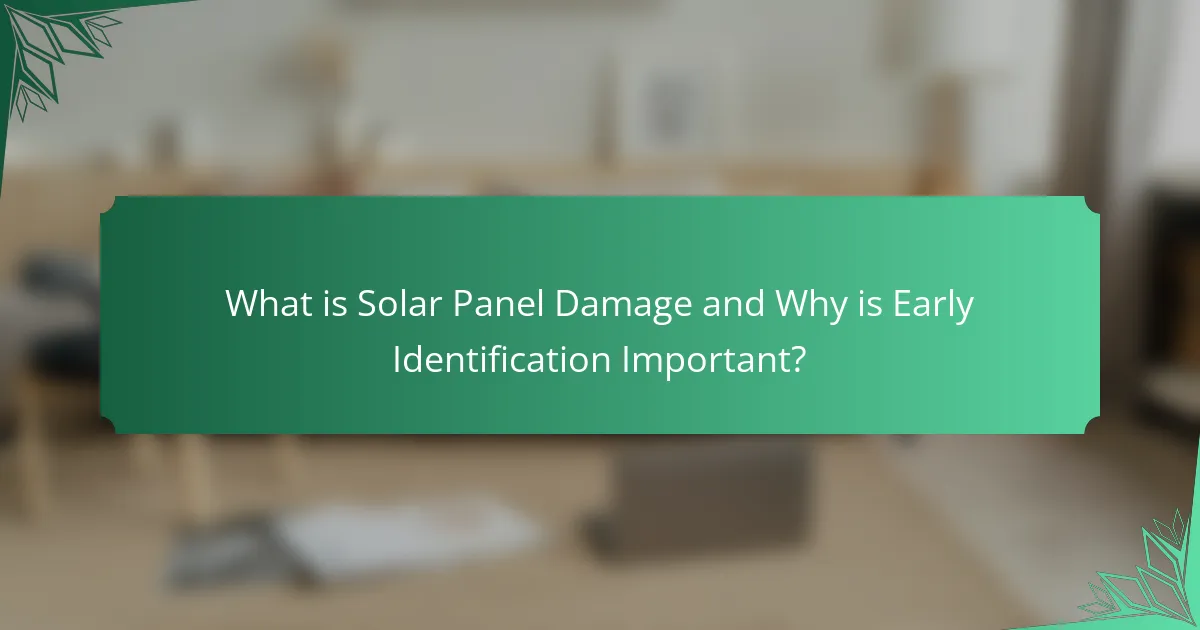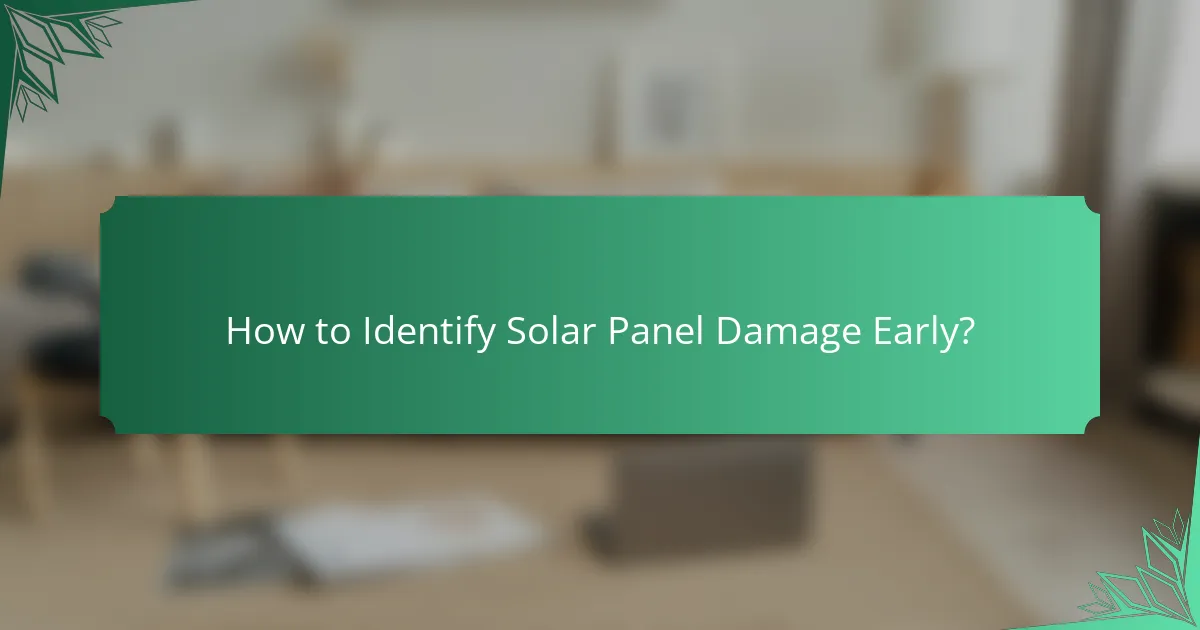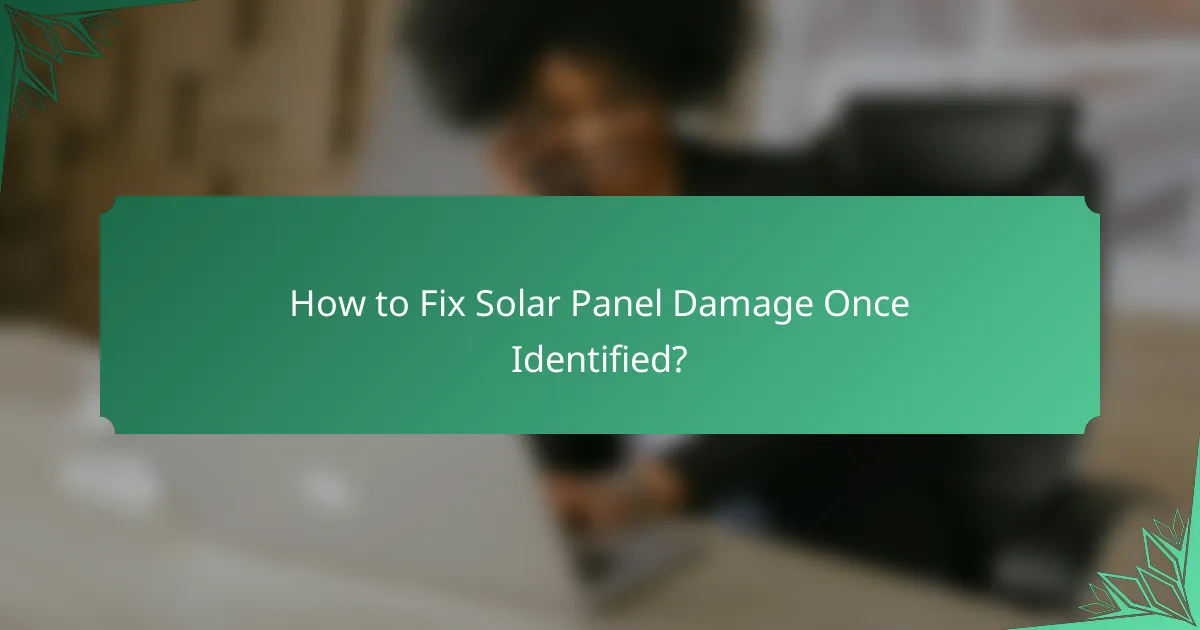
What is Solar Panel Damage and Why is Early Identification Important?
Solar panel damage refers to physical harm or degradation that affects the efficiency and functionality of solar panels. This damage can result from various factors, including environmental conditions, impact from debris, or manufacturing defects. Early identification of solar panel damage is crucial because it allows for timely repairs, which can prevent further degradation and ensure optimal energy production. Studies indicate that undetected damage can reduce solar panel efficiency by up to 20%. Regular inspections and maintenance can help detect issues early, ultimately extending the lifespan of the solar system.
How can solar panel damage impact energy efficiency?
Solar panel damage can significantly reduce energy efficiency. Physical damage, such as cracks or chips, disrupts the solar cells’ ability to convert sunlight into electricity. This can lead to decreased power output. For example, a cracked solar panel can lose up to 30% of its efficiency. Additionally, water intrusion from damage can lead to corrosion, further impairing function. Dust and debris accumulation on damaged panels can also block sunlight, compounding efficiency loss. Monitoring and promptly addressing damage is essential to maintain optimal energy production.
What are the common signs of reduced efficiency in solar panels?
Common signs of reduced efficiency in solar panels include decreased energy output and physical damage. If solar panels produce less electricity than expected, this indicates inefficiency. Dirt, debris, or shading can block sunlight and lower performance. Visual inspection may reveal cracks or discoloration on the panel surface. Overheating can occur due to poor ventilation, affecting efficiency. Monitoring system performance through inverters can show unusual drops in output. Additionally, inverter error messages may signal issues with the solar panels. Regular maintenance helps identify these signs early.
How does damage affect the overall lifespan of solar panels?
Damage significantly reduces the overall lifespan of solar panels. Physical damage, such as cracks or scratches, can lead to decreased efficiency. This damage can cause hotspots, which may further degrade the panel’s performance. Additionally, water intrusion from damaged seals can lead to corrosion. Corrosion impacts the electrical components, resulting in failures. Studies show that panels with visible damage can lose up to 25% of their efficiency. Regular maintenance can help identify damage early. Addressing issues promptly can extend the lifespan of solar panels.
What are the types of solar panel damage?
Types of solar panel damage include physical damage, electrical damage, and performance degradation. Physical damage occurs from impacts, such as hail or falling debris. This can create cracks or shattered glass. Electrical damage results from issues like short circuits or faulty wiring. This could lead to system failures or fires. Performance degradation happens over time due to factors like dirt accumulation or UV exposure. This reduces the efficiency of energy conversion. Regular inspections can help identify these types of damage early.
What causes physical damage to solar panels?
Physical damage to solar panels can be caused by various factors. Common causes include hail, falling debris, and extreme weather conditions. Hail can create dents and cracks in the glass surface. Falling branches or debris can also lead to significant damage. Additionally, high winds can displace panels or cause them to break. Other factors include improper installation and thermal cycling. Thermal cycling occurs when temperature fluctuations cause expansion and contraction, leading to stress fractures. Regular inspections can help identify these issues early.
How do environmental factors contribute to solar panel issues?
Environmental factors significantly contribute to solar panel issues. Weather conditions such as heavy rain, hail, and snow can physically damage panels. High temperatures can lead to overheating, reducing efficiency. Dust and debris accumulation can obstruct sunlight, decreasing energy output. Additionally, corrosive environments, like coastal areas, can lead to material degradation. Research indicates that solar panels in harsh climates may experience a 10-25% reduction in lifespan. Regular maintenance is essential to mitigate these environmental impacts.

How to Identify Solar Panel Damage Early?
Inspect solar panels regularly for visible cracks or discoloration. Damage may manifest as physical breaks or dark spots on the surface. Check for loose connections and ensure all wiring is intact. Monitor energy output consistently; a significant drop may indicate issues. Use a thermal camera to detect hot spots, which can signal electrical faults. Clean the panels to ensure dirt is not causing performance issues. Review the inverter for error messages that may indicate panel problems. Conducting these checks can help identify solar panel damage early, preventing costly repairs later.
What visual inspections should be conducted regularly?
Regular visual inspections of solar panels should include checking for physical damage, dirt accumulation, and connection integrity. Inspect the panels for cracks, chips, or discoloration. Dirt and debris can reduce efficiency, so ensure surface cleanliness. Examine mounting hardware for rust or corrosion. Check electrical connections for signs of wear or loose fittings. Inspect surrounding areas for shading from trees or buildings. Regular inspections help maintain optimal performance and early detection of potential issues.
How can you identify cracks or scratches on solar panels?
To identify cracks or scratches on solar panels, visually inspect the surface for any visible damage. Look for lines or breaks in the glass that indicate cracks. Scratches may appear as light marks on the panel surface. Conduct a close examination during daylight to enhance visibility of imperfections. Use a flashlight to illuminate any areas that seem suspicious. Regular inspections can help detect damage early. Research indicates that even small cracks can reduce efficiency by up to 20%.
What signs of wear should you look for on the mounting hardware?
Look for rust, corrosion, and discoloration on the mounting hardware. These signs indicate deterioration. Inspect for loose bolts or screws, as they may compromise stability. Check for cracks or deformities in the metal. Frayed or damaged protective coatings also signal wear. Regular inspections can prevent potential failures. Proper maintenance extends the lifespan of the hardware.
What tools can assist in identifying solar panel damage?
Thermal imaging cameras can assist in identifying solar panel damage. These cameras detect heat variations in solar panels. Damaged cells often exhibit different thermal signatures compared to functional ones. Multimeters are also useful for checking voltage output. A significant drop in voltage indicates potential damage. Visual inspections with a magnifying glass can reveal cracks or physical defects. Additionally, diode testers help assess the integrity of individual solar cells. These tools provide reliable means to detect issues early, ensuring optimal solar panel performance.
How can infrared cameras be used to detect issues?
Infrared cameras can be used to detect issues by identifying temperature variations in solar panels. These cameras capture thermal images that reveal hotspots. Hotspots indicate potential problems such as faulty connections or damaged cells. Infrared technology allows for non-invasive inspections. This method is faster than traditional visual inspections. Studies show that infrared thermography can find defects that are not visible to the [censured] eye. Regular use of infrared cameras can help in early detection and maintenance of solar panels. This proactive approach can extend the lifespan of solar energy systems.
What role do multimeters play in diagnosing solar panel problems?
Multimeters are essential tools for diagnosing solar panel problems. They measure electrical parameters such as voltage, current, and resistance. By measuring the output voltage of solar panels, multimeters can identify underperformance. If the voltage is significantly lower than expected, it indicates potential issues. Multimeters can also check the continuity of connections and wiring. This helps to identify broken or faulty connections. Additionally, they can measure the current flowing through the system. This measurement can confirm if the solar panel is producing adequate power. Accurate readings from multimeters help technicians pinpoint specific issues quickly. This efficiency aids in timely repairs, preventing further damage to the solar system.

How to Fix Solar Panel Damage Once Identified?
To fix solar panel damage once identified, start by assessing the extent of the damage. Minor issues like surface scratches can often be cleaned with a soft cloth and mild detergent. For cracked panels, replacement is usually necessary. Remove the damaged panel carefully and install a new one that matches the specifications of the existing system. Ensure all connections are secure to maintain efficiency. For issues with wiring or inverters, consult a professional electrician. Regular maintenance can prevent future damage and ensure optimal performance. Studies show that well-maintained solar panels can operate at up to 90% efficiency after 25 years.
What are the common repair methods for solar panel damage?
Common repair methods for solar panel damage include replacing broken glass, fixing electrical connections, and cleaning debris. Broken glass panels can be replaced to restore functionality. Electrical connections may require tightening or soldering to ensure proper current flow. Cleaning debris from panels helps maintain efficiency. These methods are essential for maintaining solar panel performance and longevity. Regular inspections can identify issues early, allowing for timely repairs.
How can minor cracks be repaired effectively?
Minor cracks in solar panels can be repaired effectively using epoxy resin or specialized adhesive. First, clean the area around the crack to remove dirt and debris. This ensures proper adhesion of the repair material. Next, apply the epoxy resin or adhesive directly into the crack. Use a small tool to push the material into the crack for complete coverage. Allow the adhesive to cure according to the manufacturer’s instructions. This method is effective as it restores structural integrity and prevents further damage. Research shows that proper repair can extend the lifespan of solar panels by preventing moisture ingress and reducing the risk of electrical faults.
What steps are involved in replacing damaged solar panels?
The steps involved in replacing damaged solar panels include assessing the damage, removing the damaged panel, and installing a new panel. First, inspect the solar panel to determine the extent of the damage. This may involve checking for cracks, discoloration, or loss of efficiency. Next, safely disconnect the damaged panel from the electrical system. Use appropriate tools to remove the mounting hardware and detach the panel. After removal, prepare the area for the new panel installation. This includes cleaning the mounting surface and ensuring it is secure. Finally, install the new solar panel by following the manufacturer’s guidelines. Reconnect the electrical connections and test the system to ensure proper functionality. These steps ensure the solar energy system operates efficiently after replacement.
When should you consult a professional for repairs?
Consult a professional for repairs when you notice significant damage to your solar panels. This includes cracks, discoloration, or any physical deformities. If your solar system is underperforming or producing less energy than expected, professional assessment is necessary. Additionally, if you see water damage or corrosion, immediate consultation is vital. Professionals can accurately diagnose issues that may not be visible to the untrained eye. Regular maintenance checks by a professional can prevent further damage and ensure optimal performance. According to the Solar Energy Industries Association, timely repairs can extend the lifespan of solar systems.
What are the indicators that a repair is beyond DIY capabilities?
Indicators that a repair is beyond DIY capabilities include complex electrical issues, structural damage, and specialized equipment needs. If the repair involves high voltage or intricate wiring, professional help is necessary. Structural damage that affects the integrity of solar panels requires expert assessment. Additionally, if specialized tools or techniques are needed, it indicates a need for a professional. Safety concerns also arise when repairs involve heights or unsafe conditions. If the repair requires knowledge beyond basic skills, it’s best to consult a professional. These indicators help ensure safety and effectiveness in solar panel repairs.
How can you choose a qualified technician for solar panel repairs?
To choose a qualified technician for solar panel repairs, verify their certifications and experience. Look for technicians who are certified by recognized organizations, such as the North American Board of Certified Energy Practitioners (NABCEP). Experience is crucial; aim for technicians with several years in the solar industry. Check customer reviews and ratings online to assess their reputation. Request references from previous clients to validate their work quality. Ensure they provide a detailed estimate before starting any repairs. This transparency indicates professionalism. Lastly, confirm they offer warranties on their work, showcasing confidence in their repair services.
What preventive measures can be taken to minimize solar panel damage?
Regular maintenance is essential to minimize solar panel damage. Cleaning panels removes dirt and debris that can block sunlight. Inspecting for cracks or loose connections helps identify issues early. Installing protective barriers can shield panels from hail or falling debris. Monitoring performance ensures any drop in efficiency is addressed promptly. Using high-quality materials during installation enhances durability. Proper installation angles prevent water accumulation, reducing the risk of damage. These measures collectively contribute to extending the lifespan of solar panels.
How can regular maintenance extend the life of solar panels?
Regular maintenance can significantly extend the life of solar panels. By routinely cleaning panels, accumulated dirt and debris are removed. This improves their efficiency and energy output. Checking for physical damage, such as cracks or loose connections, prevents further deterioration. Regular inspections help identify potential issues early. Replacing worn or damaged components ensures optimal performance. Studies show that well-maintained solar panels can last 25 years or more. In contrast, neglect can reduce their lifespan considerably.
What best practices should homeowners follow for solar panel care?
Homeowners should regularly clean solar panels to maintain efficiency. Dust, debris, and bird droppings can block sunlight. Cleaning should be done with a soft brush or sponge and water. Avoid harsh chemicals that may damage the panels. Inspect panels for cracks or discoloration at least twice a year. Early detection of physical damage can prevent costly repairs. Additionally, homeowners should check the inverter’s performance regularly. An underperforming inverter may indicate issues with the solar system. Lastly, schedule professional maintenance annually for thorough inspections. Professional technicians can identify problems that may not be visible to homeowners.
The main entity of this article is solar panel damage, which refers to physical harm or degradation affecting solar panel efficiency and functionality. The article emphasizes the importance of early identification of such damage to prevent further degradation and maintain optimal energy production. It outlines common signs of reduced efficiency, types of damage, and environmental factors contributing to issues, alongside methods for early detection and repair. Additionally, it provides guidance on preventive measures and best practices for homeowners to extend the lifespan of their solar panels.